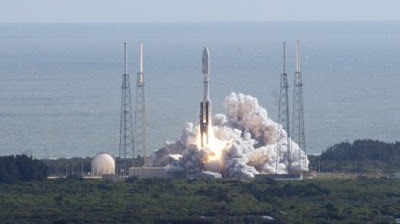On Saturday at
10:02 a.m. EST an Atlas V rocket carrying its precious cargo, the Mars Science
Laboratory and Curiosity rover, took off successfully from Space Launch Complex
41 at Cape Canaveral. A statement from NASA Project Manager Peter Theisinger
confirmed that all had gone according to plan. "The spacecraft is in
communication, thermally stable and power positive," he said. "We're
on our way to Mars".
The launch
technology that saw Curiosity on its way is an expendable system with two
distinct stages. The first, to achieve Earth orbit, utilizes the kerosene and
liquid oxygen RD-180 engine of the Atlas V rocket delivering 850,000 pounds of
thrust, supplemented by four solid rocket boosters each delivering an
additional thrust of 306,000 pounds. After separation from the main rocket, the
Centaur-3 upper stage carries the payload out of Earth orbit with the
assistance of its liquid hydrogen and liquid oxygen RL-10 engine providing
another 22,3000 pounds of thrust. Centaur then sets its cargo on course, in
this case Gale Crater, Mars, before leaving the payload to its interplanetary
cruise.
The purpose of
the $2.5 billion mission is to look for "ancient habitable
environments." After a sky-crane enabled touchdown, Curiosity will begin
its two-Earth-year/one-Mars-year mission of drilling and gathering Martian
rocks and soils, and analyzing them with its suite of ten instruments. Its goal
is to seek evidence of life-favoring conditions in the distant past.
All being well,
the Curiosity rover will touch down on August 6, 2012.
Source: NASA
Science News.

No comments:
Post a Comment